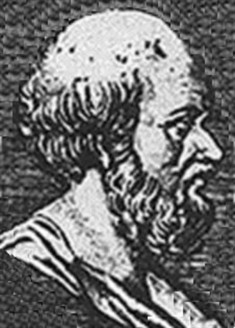| Eratosthenes | |
|---|---|
 |
|
| Mathematician | |
| Born | 276 BC Cyrene |
| Died | 194 BC Alexandria |
| Nationality | Greek |
Eratosthenes was a mathematician from ancient Greece. He was also active in the fields of astronomy, geography, music, and poetry. Eratosthenes spent most of his career at the world-renowned Library of Alexandria. His best known mathematical accomplishment was the first accurate calculation of the Earth’s circumference. He produced an improved map of the world, as well as developed a method for discovering prime numbers, known today as the Sieve of Eratosthenes.
Early Years of Eratosthenes
Only fragmentary evidence has survived about the life of Eratosthenes, but it is generally accepted that he was born in the city of Cyrene, in Libya, in about 276 B.C. His father, Aglaus, encouraged him to study in Alexandria, which at that time was the greatest center of learning in North Africa.
He was taught by the great grammar tutor, Callimachus, and began to learn philosophy from the likes of Ariston of the Stoic school and Arcesilaus the Academician. Having excelled at his studies, his abilities were noticed by King Ptolemy III Eurergetes, who commanded him to continue working in the city, replacing none other than Callimachus as the Chief Librarian at the Great Library.
He quickly became known as one of the most learned scholars in Alexandria, producing works on a wide variety of subjects. He effectively invented geography as a scientific discipline, producing a map which showed both parallels and meridians for the first time.
Some of his critics scoffed that he spent time on so many subjects that he could not lead his field in any of them, and he was given the derisive nickname “Beta” to demonstrate his supposed status of being only second best at whatever he did. He produced two books of mathematics, although these have been lost since ancient times. From remarks made by some of his contemporaries, it seems that they touched on the nature of means and loci.
Discoveries and Measurements
 Eratosthenes is best known today for his “Sieve,” a method for isolating prime numbers. He pointed out that, given a grid of numbers, one could first “sieve out” all the multiples of two, then all the multiples of three, and so on through the known prime numbers. Eventually, the only numbers remaining that had not been removed by one of these filters would themselves be primes.
Eratosthenes is best known today for his “Sieve,” a method for isolating prime numbers. He pointed out that, given a grid of numbers, one could first “sieve out” all the multiples of two, then all the multiples of three, and so on through the known prime numbers. Eventually, the only numbers remaining that had not been removed by one of these filters would themselves be primes.
He also constructed a simple machine, which was later reproduced by Eutocius and Pappus, for demonstrating the theory of two mean proportionals. Three further books, which were collectively known as the Geographica, have often been referred to as the foundations of mathematical geography.
The most impressive of all the achievements of Eratosthenes was his remarkably accurate measurement of the planet’s circumference. The idea for the calculation came to him after he was told that a certain well in Syene was illuminated to its bottom on the summer solstice, whereas this phenomenon did not occur at Alexandria.
He realized that he could use the already known distance between the two cities to derive the circumference of the “great circle” on which they lay. His final figure of 252,000 stadia represented by far the most accurate measurement of its type to that date, and for many hundreds of years thereafter.
Other Works and Later Life
Ptolemy was impressed by the mathematical feats of Eratosthenes, as reported in the commentaries of Theon. The mathematician then turned his attention to astronomy and poetry, merging the two in a work named Hermes, whose legendary status rested in part on his having given order to the heavens.
The poem went on to provide a historical description of the fixed stars. Another piece of poetry by Eratosthenes, Erigone, is now too fragmentary to fully decipher, but it is possible that it may originally have formed a part of Hermes. Still another piece, Catasterismi, has survived to the present day. This is a prose work which tells the story of some of the more significant stars.
Eratosthenes also pioneered the discipline of scientific chronology. Starting with the conquest of Troy, he worked to pin down the dates of important political and literary happenings. Meanwhile, he wrote a long treatise dealing with On the Old Comedy, which described theatrical equipment and practice in considerable detail, as well as reviewing the output of the main comic poets.
Death and Legacy
Eratosthenes is reputed to have died in Alexandria in about 195 B.C., after realizing that he was becoming totally blind. He is said to have deliberately starved himself to death to escape the possibility of having to live his last years in darkness.